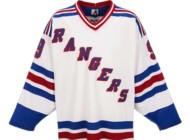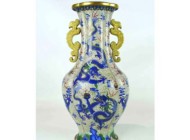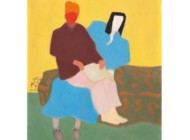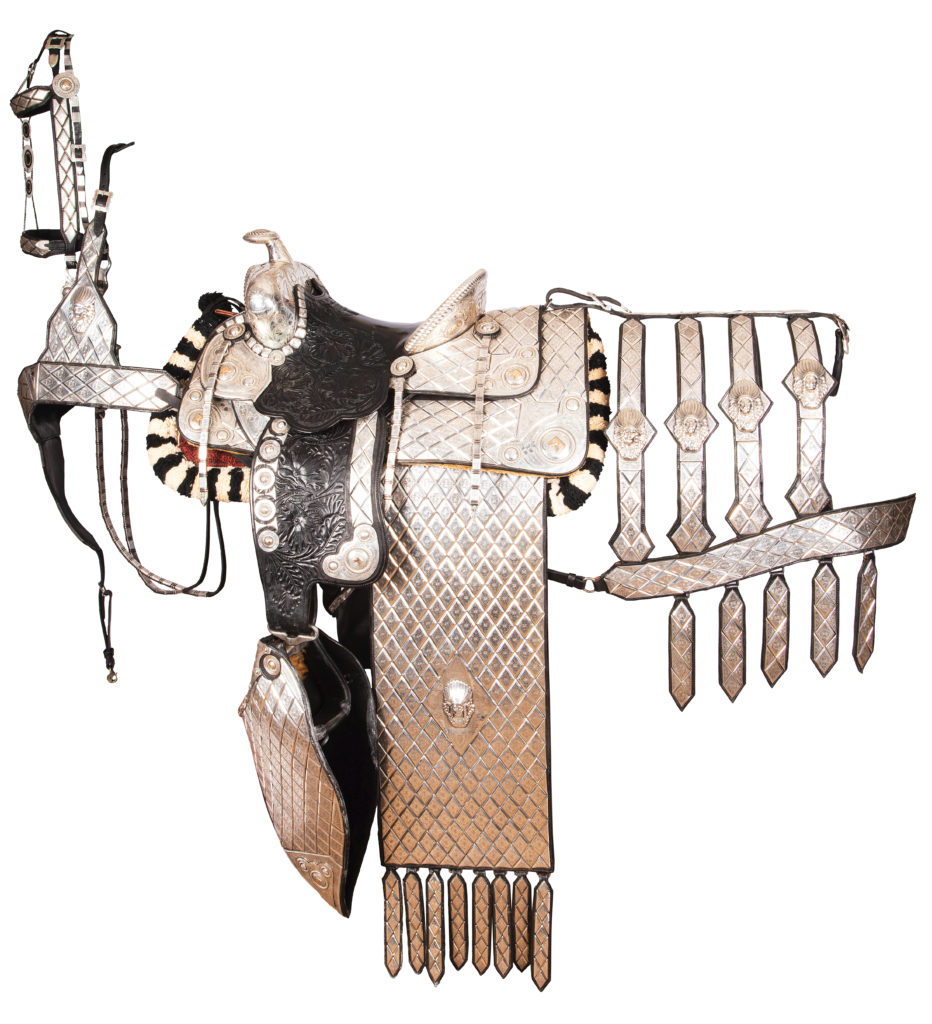
Described as the finest Keyston Bros saddle ever made, a silver parade saddle, circa 1950, lived up to its billing and marched at the head at $78,000. The silver and leather masterwork had 13 Ute Chieftain sterling decorations displayed together with all matching accessories, including serape, tapaderos, bridle and bit, martingale, corona and crupper/hipdrop. The catalog noted that Keyston Bros. bought out Heiser Saddle Co in 1950 and many silver pieces were made from original Heiser dies, including the sterling Ute Chieftain head featured on this saddle.
GREAT FALLS, MONT. — The 36th annual March in Montana auction rode to more than $2.5 million as a standing-room-only crowd assembled in Charlie Russell’s Elk Lodge on March 17-18 and witnessed many new records set for art and Western collectibles. The annual event is a highlight of Western Art Week here and is conducted by Coeur d’Alene Galleries in partnership with the Coeur d’Alene Art Auction.The live auction was presented in the Elks Lodge and drew dealers and buyers from around the world.
The two-day sale featured 766 lots with a sell-through rate of more than 98 percent, exceeding $2.5 million in final sales. “I thought the sale was very strong,” said Ron Nicklas, managing partner. “We had nearly 1,000 registered bidders for the sale and about half of them were in the crowd, which is just awesome. One of the things we really try to emphasize is the kind of ‘butts-in-the-seats’ business model, because I really think it’s a huge advantage for the consignor to have those people and that energy in the room.”
March in Montana began in the late 1980s under the aegis of Bob Nelson of Manitou Galleries. Coeur D’Alene Galleries bought his half, with Coeur D’Alene Auctions now partnering with Coeur D’Alene Galleries to mount the enterprise.
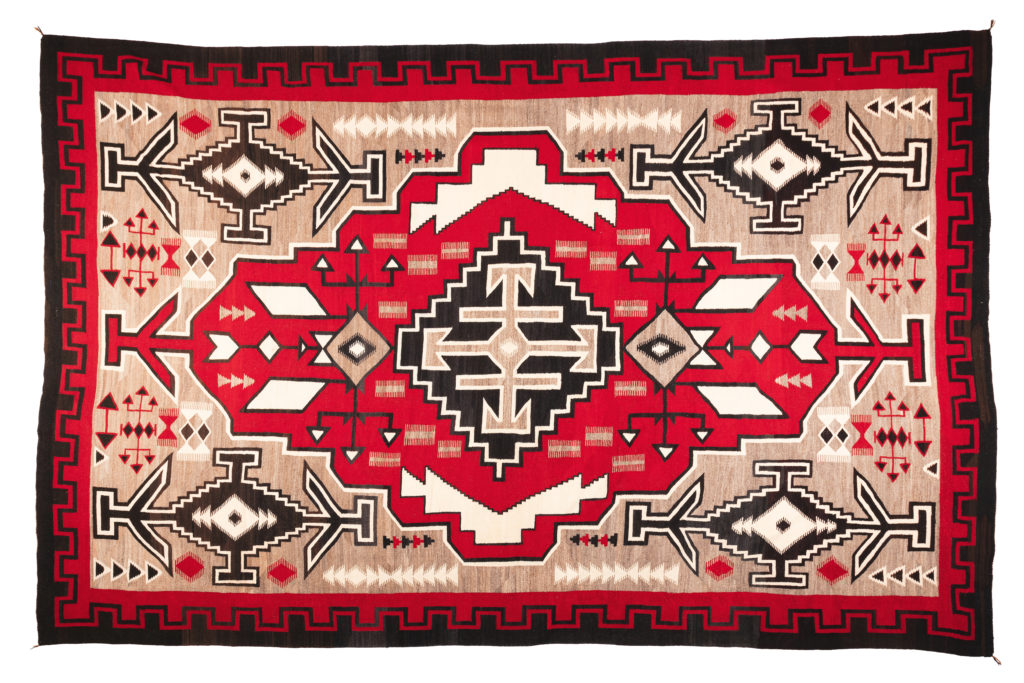
Navajo rugs from the JB Moore Crystal Trading Post area performed well. This one earning $33,000 was described as “Montana-sized” floor rug, 13 feet 7 inches by 8 feet 8 inches, circa 1920, featuring the bright red field that hosts many of the old Crystal Trading Post medallions and motifs.
Described as the finest Keyston Bros saddle ever made, a silver parade saddle, circa 1950, virtually covered with sterling silver and featuring 30 14K gold horsehead overlay decorations and more, moseyed to the top of the sale, selling for $78,000. The silver and leather masterwork had 13 Ute Chieftain sterling decorations displayed together with all matching accessories, including serape, tapaderos, bridle and bit, martingale, corona and crupper/hipdrop, which is rarely seen on any of these saddles. The silver and leather were engraved and tooled in floral designs, and “Dedicated to Millstream Hub” was engraved on cantle. Included with the saddle was a custom stand, made in the style of Ed Bohlin, four fancy rider outfits and several miscellaneous parade decorations for the horse. Keyston Bros bought out Heiser Saddle Co in 1950 and many silver pieces were made from original Heiser dies, including the sterling Ute Chieftain head featured on this saddle. There was an exceptional rifle engraved by master engraver Louis Daniel Nimschke (1832-1904) in the sale, coming out of a private North Platte, Neb., collection. The 1866 Winchester .44 rimfire with a 23½-inch octagon barrel rose above its high estimate to finish at $51,000. It boasted fine engraving, crisp with a little wear and a golden patina. The firearm was signed on bottom frame “LDN.” “They had a gun show in town at the same time [as the auction],” said Nicklas. “At one point in time during our preview on Thursday in the morning, early, there was like a line going into a museum. Word apparently got around over at the gun show about this awesome Winchester, so all of these guys, before they went to their booths, had come over to look at it.”
The first Winchester rifle — the Model 1866 — is often referred to as the “Yellowboy” because of the distinctive brass receiver, a refinement from the earlier Henry rifle. Its engraver, Nimschke, moved to the United States from Germany in 1850 and at age 18 began an engraving career that lasted a lifetime. Unlike most engravers who went to work for the firearms company, Nimschke took his work on a contractual basis, preferring to work out of his studio in New York City where he engraved firearms for such notables as Theodore Roosevelt, George Armstrong Custer, Buffalo Bill and Napoleon III.
A major draw for this annual sale is Western art, of course, and there were plenty of choice works on which to bid. Foremost was an oil on canvas by contemporary sporting artist Brett James Smith (b 1958). Selling for a record $48,000, more than two and one-half times higher than high estimate, his nearly cinematic “Summer on the Creek,” with two anglers conferring by a mountain stream, 30 by 50 inches, was signed lower right. On Smith’s website, his bio states, “Sportsmen nationwide collect his work because it is not only visually exciting but also authentic and brings to bear his intimate knowledge of his sporting experience. He is one of the few artists who brings an ageless nostalgia to his subjects. By looking back to the early illustrators such as Howard Pyle and N.C. Wyeth for inspiration, he manages to distance himself from his contemporaries.”
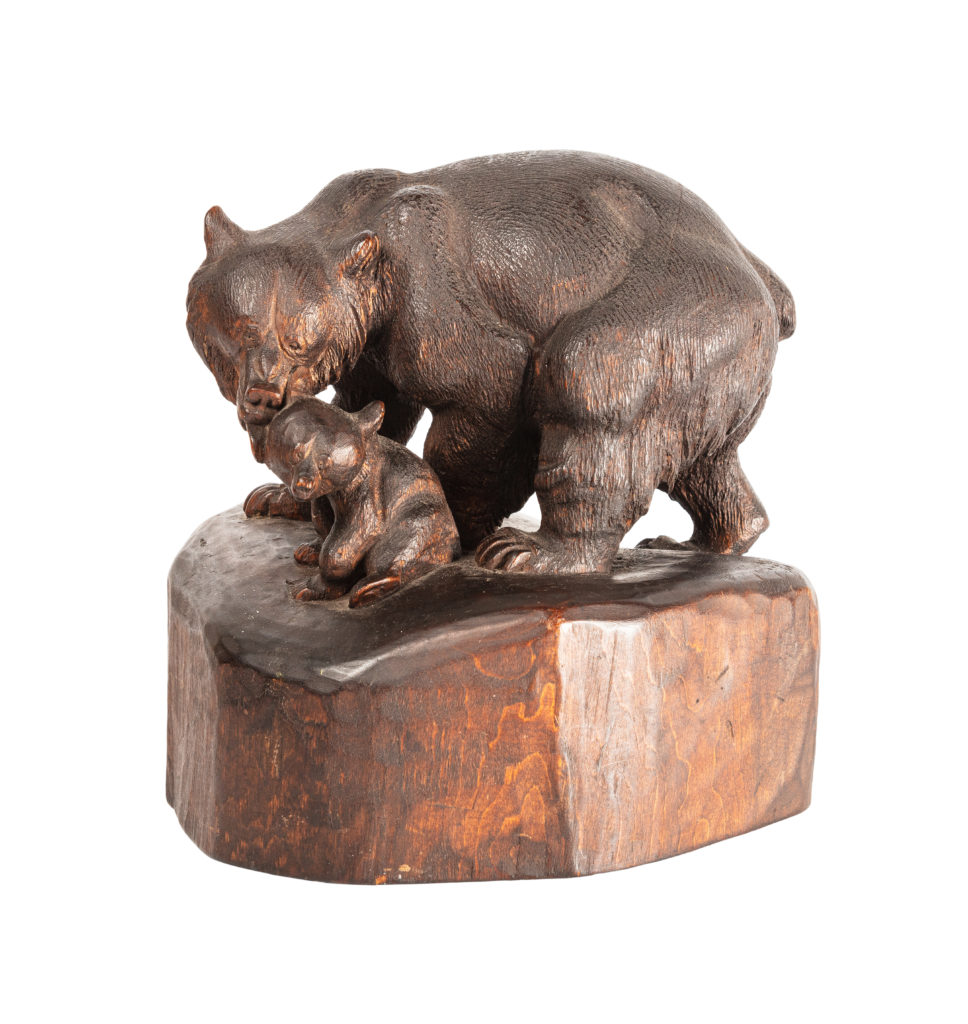
There were five sculptures by John L. Clarke (1881-1970) in the sale, the centerpiece “Mom and Her Favorite,” an 8-by-8-by-8½-inch wood carving came out of a private Bozeman, Mont., collection and brought $22,800.
An atmospheric scene of Native American horsemen amid a stampede of buffalo in “Wrong Move,” by contemporary Montana artist Don Oelze (b 1965) was bid to $42,000, more than twice its low estimate. Measuring 40 by 46 inches, the oil on canvas was signed lower right. Born in New Zealand, Oelze at an early age had a fascination with the United States and especially with the lifestyle of cowboys and Indians.
Two works by Sydney Laurence (1865-1940) were notable in the sale and both were homages to Alaska’s rugged vistas. Fetching $42,000 was “Some Old Sourdough’s Home, Anchorage, AK,” a grandly scenic oil on canvas, 16 by 20 inches, depicting a rustic abode perched among majestic, snow-splashed peaks overlooking a verdant valley with a stream. It was signed lower left and bore a sticker verso with title and dated 1927. By Laurence too, and from the same consignor, was “Iron Mountain,” also majestic with a snow-covered peak, but in this image there is no trace of humans. The 16-by-20-inch oil on canvas, signed lower right and titled verso, found a buyer at $27,000. In the Alaskan Takshanuk Mountain range, Iron Mountain’s name is derived from a large deposit of magnetite iron ore discovered in the mountain about 1869.
The solitude and wariness of a Western sheep herder’s life is captured in Bill Gollings’ (1878-1932) watercolor “Black Hank/A Sheep Herder” depicting the titular subject and his trusty canine watching over the sere landscape. The 18-by-11½-inch painting, signed lower right, left the gallery at $39,000, a tad above its high estimate. The painting had an interesting publishing provenance as explained in the catalog notes. It was featured in A Gollings Sketchbook, A Collection of Sketches by the Cowboy Artist, by Robert H. Sherger, 1973, page 12 and is titled “Black Hank;” it was also featured in Montana Western History magazine, Spring 1965, page 71. The publications were not included in the lot, but accompanying it was a copy of the book Elling William “Bill” Gollings, A Cowboy Artist, by William T. Ward and Gary L. Temple. The painting is featured on page 183 and is titled “A Sheep Herder.”
A couple of choice Navajo rugs performed well, with Nicklas commenting, “The weavings were what blew the socks off this year.” One was described as “Montana-sized” floor rug from the JB Moore Crystal Trading Post area. At 13 feet 7 inches by 8 feet 8 inches, the circa 1920 textile featured a bright red field that hosts many of the old Crystal Trading Post medallions and motifs. With corner fields, a hand carded variegated gray with bold black and white JB Moore medallions and a border in a bold, red and black chisel tooth motif going all the way around, it earned $33,000. Another Crystal Trading Post region example, circa 1930, was 18 feet 2 inches by 8 feet 4 inches with an elaborate layout of spiraling black and white stepped motifs all on a hand carded variegated grayish brown field. Woven from Native handspun Churro cross sheep wool on a wool warp, it went out at $20,400.
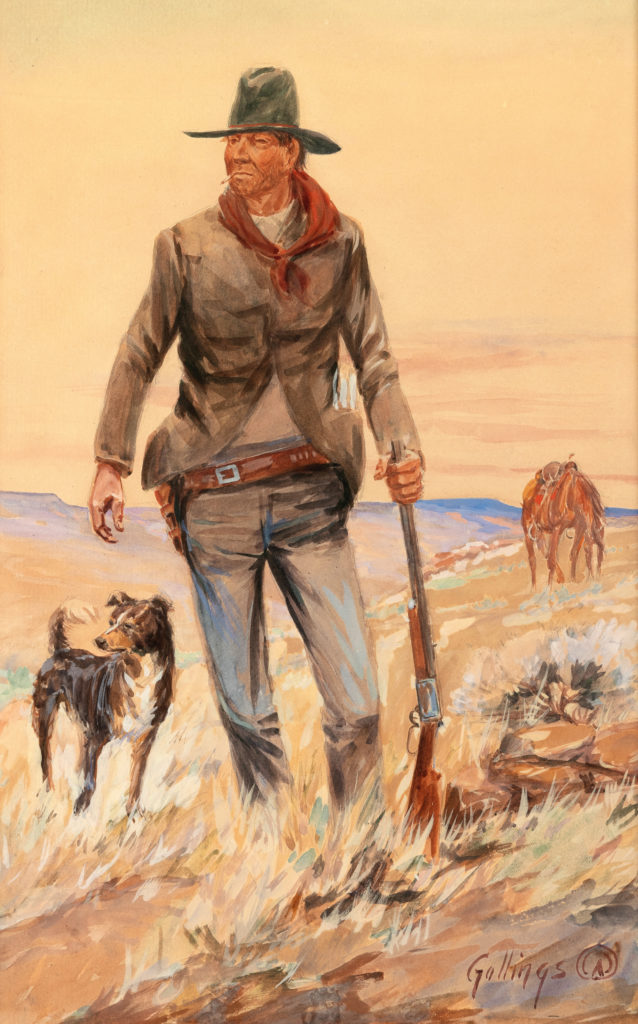
The solitude and wariness of a Western sheep herder’s life is captured in Bill Gollings’ watercolor “Black Hank/A Sheep Herder,” 18 by 11½ inches, signed lower right, which left the gallery at $39,000.
Returning to fine art, Western favorite Birger Sandzén (1871-1954) was represented by “Colorado Lake,” 1940, an oil on board, 16 by 20 inches, that sold for $30,000. Born in Bildsberg, Sweden, landscape painter and printmaker Sandzén was the son of a rural Lutheran preacher and his wife, an accomplished watercolorist. Sandzen’s pumped up palette included the brassy yellows and lush greens set against “purple mountains” majesty in this painting.
With swirls of brushwork, Earl Biss (1947-1998) in “They Rode in Slowly from Red Lodge” relates the Native American procession in his inimitable impressionistic style. A profound contributor to the explosion of Southwestern art in the last half of the Twentieth Century, and particularly to the rise of contemporary Native American art, Biss, an enrolled member of the Crow Nation — the Apsáalooke — was born in Renton, Wash., and raised by his grandmother on the Crow Reservation in southern Montana in the early years of his life. This 20-by-30-inch oil on canvas, signed upper right, took $30,000, twice its predicted high estimate.
There were five sculptures by John L. Clarke (1881-1970) in the sale, the centerpiece “Mom and Her Favorite,” an 8-by-8-by-8½-inch wood carving depicting a mama bear fastidiously grooming her cub. It came out of a private Bozeman, Mont., collection and was accompanied by original photos and documents. It brought $22,800, a world auction record for the artist.
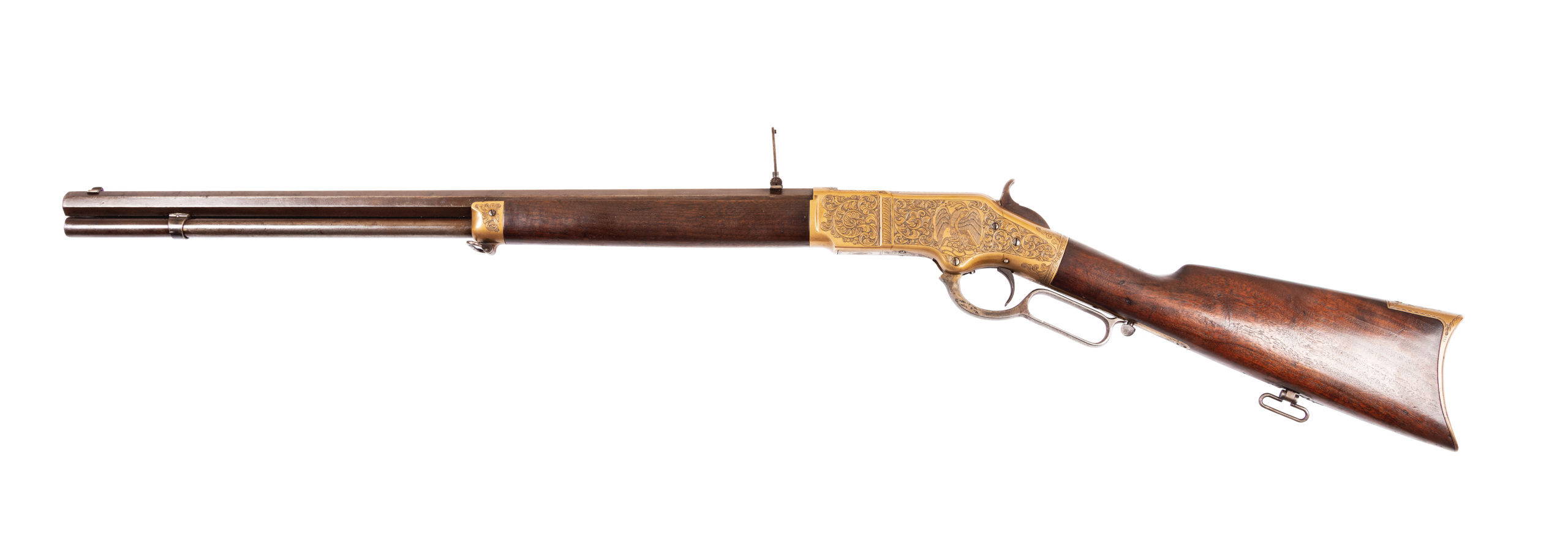
An exceptional rifle engraved by master engraver Louis Daniel Nimschke was this 1866 Winchester .44 rimfire with a 23½-inch octagon barrel, which rose above its high estimate to finish at $51,000. The firearm was signed on the bottom frame “LDN.”
Two notable bronze sculptures were Lorenzo Ghiglieri’s (1931-2020) “The Need For Buffalo,” 21 by 42 by 16 inches, which reached $16,800, and “Herd Bull” by Bob Scriver (1914-1999) $15,600. This 20-by-24-by-12-inch bronze was inscribed “7/110 ©Bob Scriver, 1959, Arrowhead Bronzeworks Stamp” and realized $15,600.
Finally, an array of Native American pieces crossed the block, the foremost being an Assiniboine/Gros Ventre war shirt, circa 1885, that changed hands for $24,000. Measuring 52 inches cuff to cuff by 26 inches long, it was beautifully beaded in geometric patterns, accented with a beaded and fringed bib. From the central Montana area, these shirts were created for special occasions, such as annual Native celebrations or sacred ceremonies like the Sun Dance.
Prices given include the buyer’s premium as stated by the auction house. Save the date for the 37th Annual March in Montana Auction and Dealer Show, March 14-16, 2024, in Great Falls for Western Art Week. For information, 208-664-2091 or www.marchinmontana.com.

















